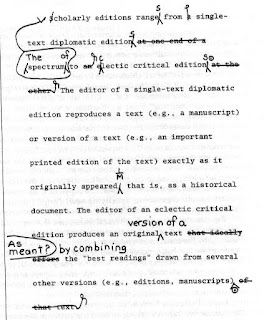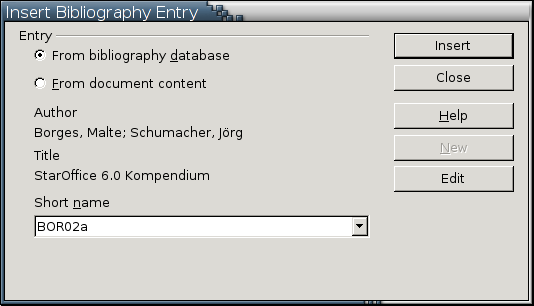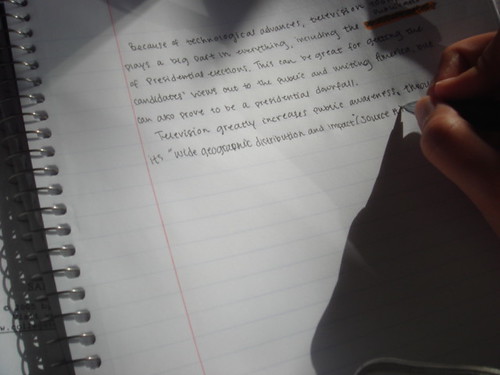Today we'll review aspects of effective writing. We'll focus on sentence clarity, strong vocabulary and the active voice.
One of our in-class activities will require us to analyse Obama's inaugural speech. We'll look for specific linguistic devices such as:
Repetition
Active voice
Passive voice
Vocabulary
Pronouns
Note: Please remember to bring all texts to Thursday's class for exam review.
Monday, November 30, 2009
Thursday, November 26, 2009
Lecture 24: Research and Proofreading
Proofreading is checking copy for
• Accuracy: spelling, grammar, punctuation, etc.
• Impression: tense, tone, intent
• Professionalism: overall appearance, clarity, conciseness
Labels:
grammar,
lecture 24,
research,
writing process
Tuesday, November 24, 2009
Lecture 23: Research Assignment Workshop
We'll spend most of today's class working on our research assignments, focussing on strong academic analysis and evaluation for the annotated bibliographies.
Here is an overview of the active and passive voice:
http://owl.english.purdue.edu/owl/resource/539/01/
Once you've read the above, complete the following quiz:
http://a4esl.org/q/h/vm/active-passive.html
**A reminder to please fill in the following survey about our library session:**
http://www.surveymonkey.com/s.aspx?sm=es32WE7fj5aFrEf7UC9SmQ_3d_3d
Labels:
assignments,
grammar,
lecture 23,
research,
verbs
Thursday, November 19, 2009
Lecture 22: Research Assignment Workshop
Today, as noted in our last class, we'll have time to complete the assignment from Tuesday (the "potty-mouth" annotation) and post it to the blog or hand in a hard copy.
What to include:
Summary:
Write 2-3 sentences about Smith’s essay.
Analysis:
Where is the author’s position/thesis statement? Write it in your own words.
Where are Smith’s reasons? Find them and number them.
What kind of evidence does Smith use as support for his position?
How does Smith arrange these reasons (what is the logic)? Write 1-2 sentences about the rationale you think Smith uses to choose and arrange the reasons.
Does Smith consider alternative views or opposing perspectives? Write a sentence about the effectiveness (or not!) of the placement.
Ethos/Evaluation:
How reliable is the author?
Who is he?
Would you trust his view?
Is Smith well informed? How do you know?
Does Smith tell how he is connected to the issue?
We'll then spend the remainder of the class working on our research assignments, focussing on strong academic analysis and evaluation for the annotated bibliographies.
*****Homework*****
For Tuesday (24th of November) please reach Chapter 22 in Handbook for Writers.
What to include:
Summary:
Write 2-3 sentences about Smith’s essay.
Analysis:
Where is the author’s position/thesis statement? Write it in your own words.
Where are Smith’s reasons? Find them and number them.
What kind of evidence does Smith use as support for his position?
How does Smith arrange these reasons (what is the logic)? Write 1-2 sentences about the rationale you think Smith uses to choose and arrange the reasons.
Does Smith consider alternative views or opposing perspectives? Write a sentence about the effectiveness (or not!) of the placement.
Ethos/Evaluation:
How reliable is the author?
Who is he?
Would you trust his view?
Is Smith well informed? How do you know?
Does Smith tell how he is connected to the issue?
We'll then spend the remainder of the class working on our research assignments, focussing on strong academic analysis and evaluation for the annotated bibliographies.
*****Homework*****
For Tuesday (24th of November) please reach Chapter 22 in Handbook for Writers.
Labels:
analysis,
assignments,
essay,
lecture 22,
persuasive,
research
Monday, November 16, 2009
Lecture 21: Research and Annotation
Outline:
Pre-Reading Activity
Short Video
Read “Potty-Mouthed and Proud of It” (413)
Group Work
Homework
*****Homework*****
Bring all texts, articles, laptops, dictionaries to next class (Thursday 19th November) to help you work on your Research Assignment
Post “Potty-Mouthed” Dictionary Entry to the class blog BEFORE Thursday 9:30am (one entry per group, note all group members).
Note: Image from Linux Journal.
Labels:
analysis,
argument,
lecture 21,
persuasive,
research,
summaries
Saturday, November 14, 2009
Library Research Session: Feedback Required
Following your library session, please fill in the following survey:
http://www.surveymonkey.com/s.aspx?sm=es32WE7fj5aFrEf7UC9SmQ_3d_3d
http://www.surveymonkey.com/s.aspx?sm=es32WE7fj5aFrEf7UC9SmQ_3d_3d
Wednesday, November 11, 2009
Lecture 20: Thesis Statements
Please add your thesis statement as a comment to this blog post. Remember, your thesis statement should pertain to your public discussion topic. If you'd like to choose a different topic, please let me know before you craft your thesis statement.
Since your thesis statements are drawn from your public discussion topics I'm asking you to imagine writing an "argumentative" essay. This type of essay usually:
"makes a claim about a topic and justifies this claim with specific evidence. The claim could be an opinion, a policy proposal, an evaluation, a cause-and-effect statement, or an interpretation. The goal of the argumentative paper is to convince the audience that the claim is true based on the evidence provided."
*****Example Thesis Statement*****
Example of an argumentative thesis statement:
High school graduates should be required to take a year off to pursue community service projects before entering college in order to increase their maturity and global awareness.
Read more about writing thesis statements at OWL and here and here.
Here is some interesting information on the "myths about thesis statements."
Note: Image from arghh_im_a_pirate on flickr.
Since your thesis statements are drawn from your public discussion topics I'm asking you to imagine writing an "argumentative" essay. This type of essay usually:
"makes a claim about a topic and justifies this claim with specific evidence. The claim could be an opinion, a policy proposal, an evaluation, a cause-and-effect statement, or an interpretation. The goal of the argumentative paper is to convince the audience that the claim is true based on the evidence provided."
*****Example Thesis Statement*****
Example of an argumentative thesis statement:
High school graduates should be required to take a year off to pursue community service projects before entering college in order to increase their maturity and global awareness.
Read more about writing thesis statements at OWL and here and here.
Here is some interesting information on the "myths about thesis statements."
Note: Image from arghh_im_a_pirate on flickr.
Labels:
argument,
assignments,
lecture 20,
persuasive,
rhetoric,
thesis
Monday, November 9, 2009
Lecture 19: Library Research Session
Today we're meeting in the library, room 327, for a session devoted to finding scholarly materials for your research projects.
Labels:
assignments,
lecture 19,
mla style,
persuasive,
research
Wednesday, November 4, 2009
Public Discussion Analysis
Assignment: Public Discussion Analysis
Due: 10th November, Start of Class
Details: In a one page analysis of your group’s topic and debate you will have four sections:
· Debate Resolution
· Background
· Arguments (both pro and con)
· Works Cited (follow MLA style and include all YouTube videos as well)
NOTE: Each member of the group must hand in their own analysis but the group may collaborate during the writing stage.
SAMPLE Public Discussion Analysis
Resolution: Resolved, that handguns should not be protected under the provisions of the Second
Amendment.
Background: The United States has the most liberal gun ownership policy in the world and the highest crime rates in the world also. The National Rifle Association has for years had a vice grip on lawmakers when even the slightest hint of a handgun control bill is introduced into Congress. One of their typical arguments is that unlimited handgun possession is a guaranteed right protected by the Second Amendment. The time has come for the Supreme Court to decide the issue once and for all: is the wording of the amendment made under conditions existing in the late 1770s when militias were part of our national defense applicable to the late 1990s when people are afraid for their lives because every petty thief or robber could easily be carrying a handgun? When South Carolina passed a law that regulated the sale of handguns experimentally for a three year period, there was 28% reduction in the number of homicides committed with handguns. The time has come for the courts to recognize that there have been abuses promulgated by the Second Amendment and that it is time for us to care more about protecting our personal lives than protecting an outmoded wording within the Second Amendment. It's time to keep to the intent of the Founding Fathers and change the wording accordingly.
Arguments: The Second Amendment should not apply to handguns—especially firearms used for illegal purposes. Because handguns are so easily concealed, they do not have any reasonable relationship to the preservation of the efficiency of a "well-regulated militia." In the Supreme Court case United States V.
Cruisckshank, it was determined that the Second Amendment only applied to the "bearing of arms for a
lawful purpose."
Interpreting the Second Amendment to apply to personally-owned handguns tends to validate the use of handguns for a variety of inappropriate behaviors. "Deadly at No Cost," in Time reports that 40% of handgun deaths were suicides, 26% were accidental deaths and that 10% were felony related (24). Over three-quarters of the remaining handgun killings were related to guns that were originally bought to protect a family but became weapons of destruction. Additionally, 65% of all homicides in the U.S. are "crimes of passion" in which the victim knows his or her killer; this is hardly an argument for a "well-regulated militia" (25).
With total protection of gun ownership afforded by the Second Amendment, it is impossible to keep guns out of the hands of the undesirable. Most provisions of the Brady Law dealing with registration have been disallowed by the courts. People with criminal records or a history of mental instability can still purchase lethal weapons. "Ready, Aim, Fire at our Youth," describes how handguns make it onto high school, junior high school and even elementary school campuses as the black market for guns caters to youth (40).
Works Cited:
South Carolina Law Review, 1975: 45. Print.
"Deadly at No Cost," Time Magazine, February 3, 1992: 24-25. Print
Congressional Quarterly, January, 1992: 218-232. Print
"Ready, Aim, Fire at our Youth," Newsweek, February 17, 1992: 40-44. Print
"One Gun Too Many," Los Angeles Times, September 1, 1995: 1. Print
Labels:
argument,
assignments,
logic,
persuasive,
rhetoric
Lecture 18: Public Discussions Part II
Today the remaining groups shall present their topics and debate for the class.
Your public discussion analysis assignment is added to the blog for you to peruse. Please hand it in on Tuesday before we begin our library session. Remember to come straight to the library for our research session which will help with the research assignment due on the 1st of December. We will be meeting in the Instruction Lab (it is room 347).
Note: Your thesis statement is due on Thursday by 11:00am (as a comment on next Thursday's blog post). Remember, this is the thesis statement based on your public discussion topic. You will have the class period as a research session to work on your thesis statements. This work can be done in the library.
Your public discussion analysis assignment is added to the blog for you to peruse. Please hand it in on Tuesday before we begin our library session. Remember to come straight to the library for our research session which will help with the research assignment due on the 1st of December. We will be meeting in the Instruction Lab (it is room 347).
Note: Your thesis statement is due on Thursday by 11:00am (as a comment on next Thursday's blog post). Remember, this is the thesis statement based on your public discussion topic. You will have the class period as a research session to work on your thesis statements. This work can be done in the library.
Labels:
argument,
logic,
persuasive,
rhetoric,
student presentations
Tuesday, November 3, 2009
Lecture 17: Public Discussions Part I
Today half of the class will present their topics and debate for the class.
The class and I shall assess each group based on five criteria as noted last class and here in this rubric.
The class and I shall assess each group based on five criteria as noted last class and here in this rubric.
Thank you to groups 2 and 5 who set great examples of how an argument is set up and developed. Good rebuttals too.
Groups 1, 3 and 4 be ready for Thursday.
Labels:
argument,
logic,
persuasive,
rhetoric,
student presentations
Subscribe to:
Posts (Atom)









